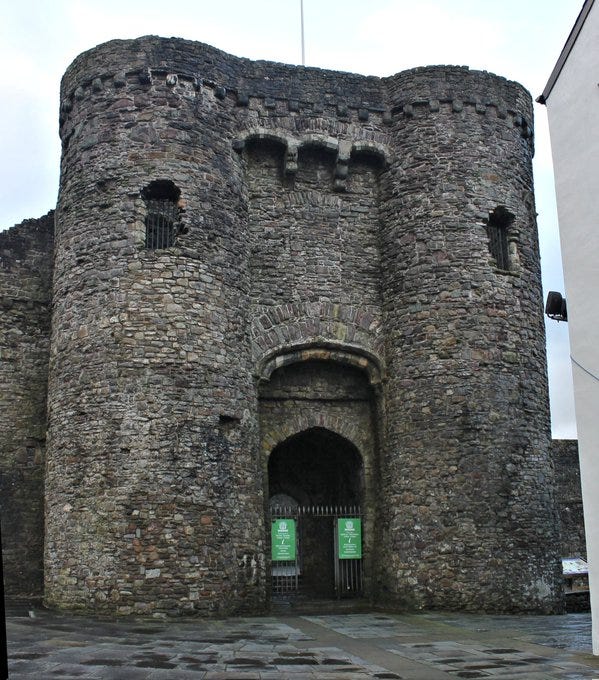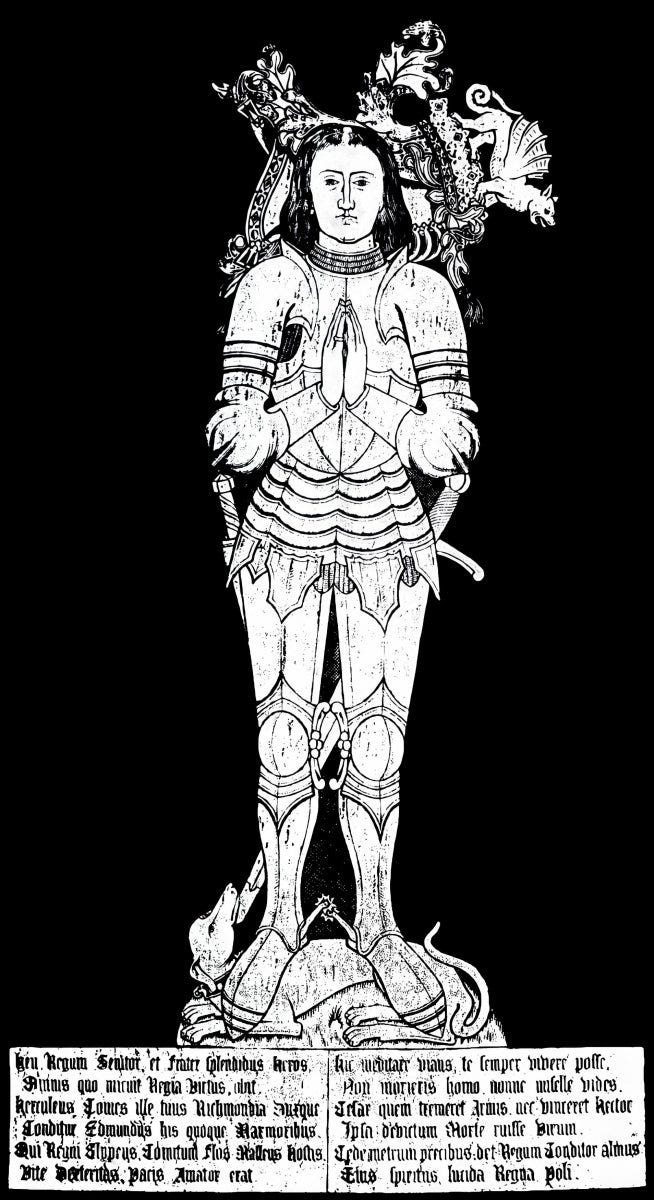Edmund Tudor's War, and Murder (?), in Wales
On 1st November 1456, Edmund Tudor died in Carmarthen. Was it plague or was it murder?
On 1st November 1456, Edmund of Hadham, Earl of Richmond, died in Carmarthen. History knows him better as Edmund Tudor, husband of Margaret Beaufort and father of Henry VII, the first Tudor king of England. History suggests Edmund died of plague, but I think, considering the circumstances, there is good reason to suggest something more sinister.
What was Edmund doing in West Wales in the first place? Well, with law and order collapsing throughout England and Wales during the mid-fifteenth century, symptomatic of weak kingship which was leading to a bitter collapse in relations between the nobles of land, there were pockets of disorder where local landowners were, in essence, acting up.
In Carmarthenshire during this period, the landowner who had risen to the fore amongst the south Welsh was Gruffydd ap Nicholas, an experienced, intelligent, and ruthless man. He was later described, probably accurately, by a descendant as having a ‘hot, fiery, and choleric spirit'. He was contemptuous of royal authority, ignored instructions from the King’s Council, and had made himself rich through a reign of terror in West Wales. He was known, not for nothing, as ‘the eagle of Carmarthen’.
It was decided something had to be done about Gruffydd, so in 1456, Edmund Tudor was sent into Wales to deal with him by the protector, Richard, Duke of York. He was a decent choice – a half-brother of the king ready to show what he was made out of, Edmund had strong links with Wales through his father Owen Tudor, descended from a highly respected Welsh family that was distantly related to Gruffydd. York was particularly keen to see Gruffydd surrender lordships that belonged to the duke, principally Carmarthen.
And so, Edmund travelled into West Wales with his new bride in tow, the 12-year-old Margaret Beaufort, a wealthy heiress. They reached Lamphey, near Pembroke, by the end of November 1455. It is believed that during this progress, possibly at Lamphey, the 26-year-old Edmund impregnated Margaret. If he had a child with her, he would receive a lifetime interest in her lands. It was grasping, it was devious, and it was unpalatable, even for the standards of the day, for she was still just a child herself. If Edmund had any concerns over the physical or mental wellbeing of his young countess, then they were callously set aside in favour of his own self-interest.
Once stationed in Wales, Edmund went to work, attempting to remove Gruffydd from the royal castles of Aberystwyth, Carmarthen and Carreg Cennen and reasserting crown authority. By June 1456, the pair were regarded as being ‘at war greatly in Wales’, but Edmund was soon successful, recapturing Carmarthen by August.
But things had changed in London in the interim. The Duke of York had now been removed from power, the Lancastrian faction were rallying, and now York viewed Edmund Tudor, a die-hard Lancastrian fostering a powerbase in Wales, as a direct threat. York now wanted to strengthen his position in Wales, and this meant he needed what he viewed as HIS castles, back from Edmund.
And so, Edmund went from fighting Gruffydd ap Nicholas and his proxies to direct conflict with the Yorkists. The men the Duke of York ordered to suppress Edmund Tudor were his trusted tenants Sir Walter Devereux of Weobley, and Devereux’s son-in-law Sir Walter Herbert of Raglan. The Herberts and the Tudors were dynastic rivals in Wales, so there was no love lost between the parties.
With a force numbering around two thousand armed men, the Yorkists descended upon Carmarthen, one of the largest Welsh fortresses of its day, and besieged Edmund within. It is unclear how much violence occurred here in the late summer and early autumn of 1456, but the Yorkists seized control of Carmarthen and arrested Edmund Tudor.
We cannot know the circumstances of Edmund’s arrest or the period he spent in custody, but by 1 November 1456, just a few weeks after he was captured, the Earl of Richmond was dead.
The cause of Edmund’s death has commonly been attributed to an outbreak of the plague, but there is no contemporary indication this was the case. It must be considered Edmund may have died because of injury sustained during the recent attack on Carmarthen, or even yet, because he was murdered.
The Yorkists had already shown themselves capable to eliminating their rivals in a violent manner – the previous year at St Albans, the Yorkists attacked the royal entourage and assassinated the leader of the Lancastrian faction, Edmund Beaufort, Duke of Somerset.
It is notable that Beaufort was a dynastic rival to York, both of whom had claims to the throne if the Henry VI’s line faltered. With news spreading that Margaret Beaufort was pregnant, her child with Edmund Tudor inheriting her own claim to the throne, was there a suspicion in Yorkist circles that the Tudor had designs on greater power in future? Perhaps.
We need to look at contemporary suspicion of the Yorkist ringleaders, Herbert and Devereux. For several months afterwards, both men were pursued by the Lancastrian crown. Because of widespread ‘mischief and grievance’ the pair had presided over, accused of robbing, beating, maiming, and killing the king’s subjects, they were thrown into prison, Herbert at the Tower of London and Devereux at Windsor. In March 1457, five months after Edmund’s death, Herbert was bailed, but within days had fled back to Wales, ‘to pursue his evil course’. He was regarded ‘a rebel put out of the king’s grace’.
Finally, in April 1457, an inquisition was held in Hereford to discuss events at Carmarthen. Herbert was one of 57 people investigated, and those present included Henry VI, his queen Margaret of Anjou, and Edmund’s brother Jasper Tudor. But a deal was struck before full details could be heard – the queen offered to pardon Herbert if he left York’s side and joined the Lancastrians. Herbert agreed, for the time being at least. Devereux remained in prison until the following year. And so, the cause of Edmund Tudor’s death remains, frustratingly, an unanswered question.
In death, Edmund’s body was claimed by the monks of Carmarthen’s Grefriars and buried within their monastery church. A new tomb was commissioned in 1496 by the son he never lived to see born, Henry Tudor, by then King Henry VII of England. Henry commissioned the most prominent Welshman of his day, Rhys ap Thomas, to oversee the new tomb. Rhys, incidentally, was a grandson of Gruffydd ap Nicholas, neatly bringing that story to its conclusion.
The tomb was moved after the dissolution of the Greyfriars in 1538 and moved to its present location, standing before the altar in St David’s Cathedral, the holiest site in Wales.
Around the base of the tomb chest are twelve restored shields bearing the arms of Edmund’s immediate and extended family, including those of his parents Owen Tudor and Katherine of Valois, his wife Margaret Beaufort and the previous three generations of her family, plus those borne after his death by his son Henry VII and grandsons Henry VIII and Arthur. In all but two of the twelve shields, the quartered royal arms of England and France appear, a conscious reminder to visitors of Edmund’s many royal connections, in life and in death.
There are no surviving accounts of Edmund’s appearance, and no record that reveals his character. The monumental brass that adorns his tomb, a later addition and not contemporary, depicts a grave armoured figure with shoulder-length hair and his hands in prayer, a rather generic representation of a fifteenth-century nobleman. Above Edmund’s left shoulder rests a dragon, and at his feet the Richmond greyhound. An epitaph around the tomb chest, added after 1485, reads proudly:
'Under this marble stone here enclosed resteth the bones of the noble Lord, Edmund Earl of Richmond, father and brother to kings; the which departed out of this world in the year of our Lord God, 1456 the first day of the month of November; on whose soul Almighty Jesu have mercy. Amen'.
Son of Prophecy: The Rise of Henry Tudor
Much of the above is an abridged version of what appears in my Tudor family biography, ‘Son of Prophecy’. If you are interested in learning much more about Edmund’s war in Wales, or Margaret Beaufort’s struggles being a very very young mum to Henry Tudor, and how that boy was able to grow up to become a king, the book is onsale everywhere now.
Fourteen years in the making, from defiant Welsh rebels to unlikely English kings, this is the story of the Tudors, but not how you know it.
Order BY CLICKING HERE










Keep up the great work Nathen!
How interesting, even for a non Brit, thank you Nathan! Lot of work you invested in this, regards from Athens